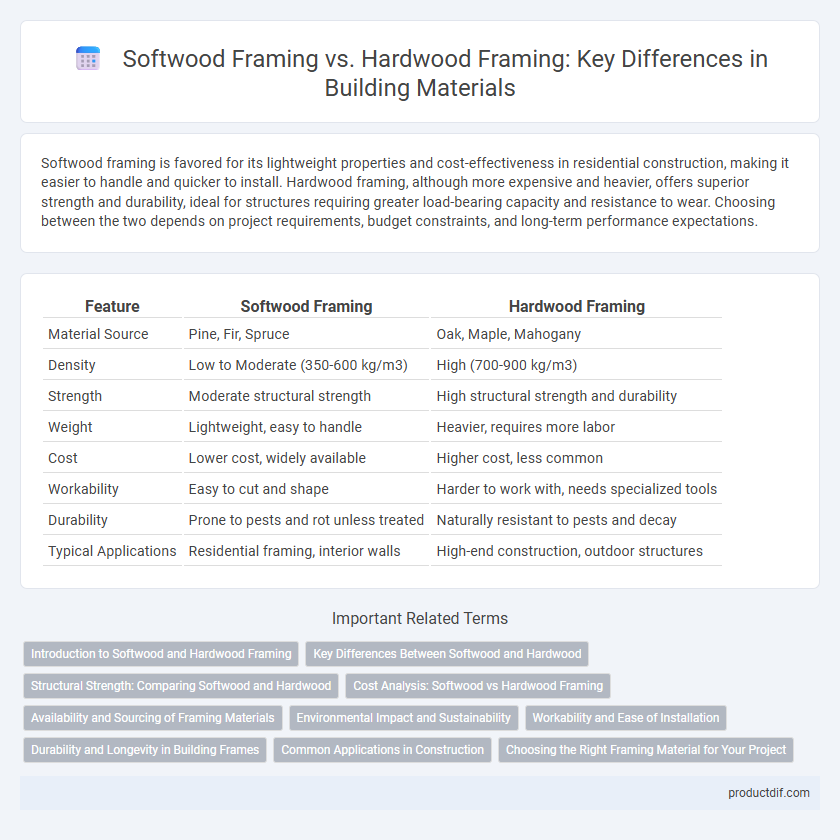Softwood framing is favored for its lightweight properties and cost-effectiveness in residential construction, making it easier to handle and quicker to install. Hardwood framing, although more expensive and heavier, offers superior strength and durability, ideal for structures requiring greater load-bearing capacity and resistance to wear. Choosing between the two depends on project requirements, budget constraints, and long-term performance expectations.
Table of Comparison
| Feature | Softwood Framing | Hardwood Framing |
|---|---|---|
| Material Source | Pine, Fir, Spruce | Oak, Maple, Mahogany |
| Density | Low to Moderate (350-600 kg/m3) | High (700-900 kg/m3) |
| Strength | Moderate structural strength | High structural strength and durability |
| Weight | Lightweight, easy to handle | Heavier, requires more labor |
| Cost | Lower cost, widely available | Higher cost, less common |
| Workability | Easy to cut and shape | Harder to work with, needs specialized tools |
| Durability | Prone to pests and rot unless treated | Naturally resistant to pests and decay |
| Typical Applications | Residential framing, interior walls | High-end construction, outdoor structures |
Introduction to Softwood and Hardwood Framing
Softwood framing, derived primarily from coniferous trees such as pine, fir, and spruce, is widely favored in residential construction due to its lightweight properties, ease of handling, and cost-effectiveness. Hardwood framing, sourced from deciduous trees like oak, maple, and hickory, offers superior strength and durability, making it ideal for structures requiring enhanced load-bearing capacity and long-term resilience. The choice between softwood and hardwood framing depends on factors including structural requirements, budget considerations, and environmental impact.
Key Differences Between Softwood and Hardwood
Softwood framing typically uses species like pine, fir, and spruce, valued for their lighter weight and ease of handling in construction, while hardwood framing employs denser woods such as oak, maple, and hickory, offering greater strength and durability. Softwood frames provide better flexibility and faster growth rates, making them more sustainable and cost-effective, whereas hardwood frames excel in resistance to wear, impact, and environmental damage over time. The choice between softwood and hardwood framing impacts structural integrity, project cost, and longevity, with softwoods favored in residential builds and hardwoods preferred for heavy-duty or decorative applications.
Structural Strength: Comparing Softwood and Hardwood
Softwood framing, commonly sourced from species like pine, fir, and spruce, offers sufficient structural strength for most residential and commercial buildings due to its favorable strength-to-weight ratio and ease of handling. Hardwood framing, derived from trees such as oak, maple, and hickory, typically provides superior density and higher compressive strength, making it ideal for applications requiring enhanced load-bearing capacity and durability. While hardwood framing delivers greater long-term structural integrity, softwood framing remains a cost-effective and versatile solution for framing needs where extreme strength is not the primary concern.
Cost Analysis: Softwood vs Hardwood Framing
Softwood framing generally costs significantly less than hardwood framing due to faster growth rates and greater availability, making it a preferred choice for budget-conscious construction projects. Hardwood framing, while more expensive, offers superior strength and durability, which may justify higher initial costs for structures requiring enhanced longevity. Analyzing regional price variations and project scale can further optimize material selection between softwood and hardwood framing.
Availability and Sourcing of Framing Materials
Softwood framing materials, primarily sourced from coniferous trees like pine and spruce, are more widely available due to faster growth rates and sustainable forestry practices, ensuring consistent supply for construction projects. Hardwood framing, derived from deciduous trees such as oak and maple, tends to have limited availability and higher costs because of slower growth and stricter harvesting regulations. The sourcing of softwood framing supports large-scale construction with ease, while hardwood framing is generally reserved for specialized applications requiring enhanced durability or aesthetic appeal.
Environmental Impact and Sustainability
Softwood framing, sourced primarily from fast-growing coniferous trees like pine and spruce, offers a more sustainable option due to its quicker replenishment rate and lower carbon footprint compared to hardwood. Hardwood framing, derived from slow-growing deciduous trees, often results in greater ecological strain because of slower regeneration and higher embodied energy. Choosing softwood framing promotes reduced deforestation impact and supports sustainable forest management practices essential for environmental conservation.
Workability and Ease of Installation
Softwood framing offers superior workability due to its lightweight nature and uniform grain, making it easier to cut, nail, and handle during installation. Hardwood framing, while more durable, is denser and requires specialized tools, increasing installation time and labor costs. Builders often prefer softwood for projects prioritizing speed and ease, whereas hardwood is chosen for added strength and longevity despite its installation challenges.
Durability and Longevity in Building Frames
Softwood framing is favored for its cost-effectiveness and ease of handling, but it generally offers lower durability and a shorter lifespan compared to hardwood framing. Hardwood framing provides superior strength and resistance to environmental factors, resulting in greater longevity and structural integrity in building frames. Selecting hardwood reduces the need for frequent repairs and replacements, enhancing the overall durability of construction projects.
Common Applications in Construction
Softwood framing is widely utilized in residential construction for its affordability, ease of use, and availability, making it ideal for walls, roofs, and floors in houses. Hardwood framing, known for its superior durability and strength, is commonly employed in high-stress structural components, custom millwork, and specialist architectural features. Softwood remains dominant in light framing applications, while hardwood is chosen for heavy-duty framing where longevity and resistance to wear are crucial.
Choosing the Right Framing Material for Your Project
Softwood framing, commonly sourced from pine, fir, or cedar, offers cost-effective, lightweight, and easy-to-work characteristics ideal for residential construction and interior projects. Hardwood framing, derived from species like oak, maple, or hickory, provides superior strength, durability, and resistance to wear, making it suitable for heavy-load structures or decorative finishes. Selecting the right framing material depends on project requirements such as load-bearing capacity, budget constraints, environmental conditions, and desired aesthetic appeal.
Softwood Framing vs Hardwood Framing Infographic

 productdif.com
productdif.com